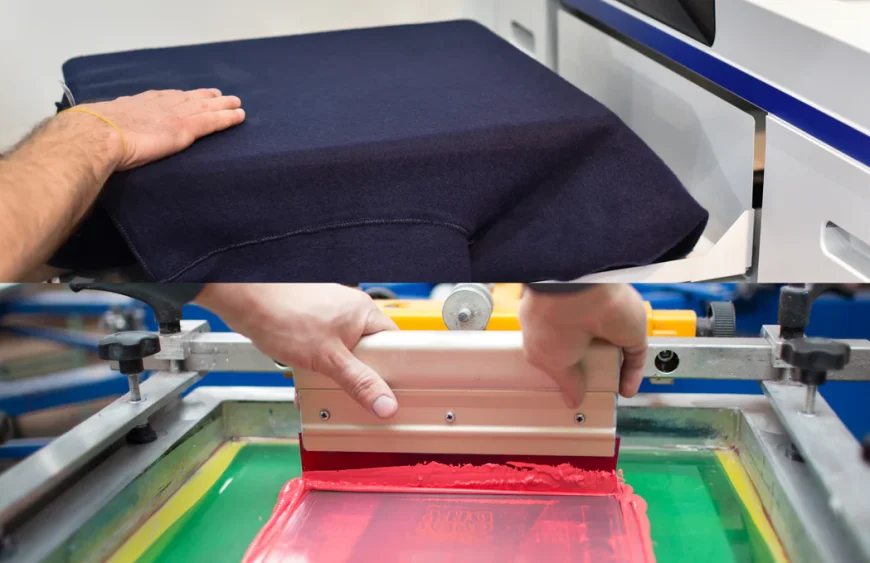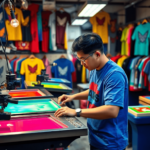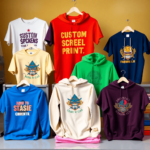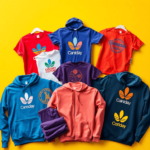
A Comprehensive Guide to Screen Printing vs. Direct-to-Garment Printing
When it comes to custom t-shirt printing, there are two main methods to choose from: screen printing and direct-to-garment (DTG) printing. Both have their own unique benefits and drawbacks, and the right choice for your project will depend on your specific needs and goals.
In this guide, we’ll take a closer look at screen printing and DTG printing, comparing and contrasting the two methods to help you determine the best option for your project.
What is Screen Printing?
Screen printing is a printing technique that involves creating a stencil (also known as a “screen”), and then using that stencil to apply ink to the garment. The ink is pushed through the screen onto the garment using a squeegee, and the stencil blocks the ink from certain areas to create the desired design.
Pros of Screen Printing
- Wide range of customization options: With screen printing, you have a lot of flexibility when it comes to customization. You can print on a wide range of garment styles and sizes, and use a variety of inks and special effects (such as foil printing and glitter) to achieve the desired look.
- Durable prints: Screen printing produces prints that are very durable and resistant to fading or cracking. This makes it a good choice for garments that will be worn or washed frequently.
- Economical for large orders: Screen printing is an economical choice for large orders, as the setup costs are relatively low compared to DTG printing.
Cons of Screen Printing
- Higher upfront costs: While screen printing is more economical for large orders, the upfront costs can be higher for smaller orders. This is because each color in the design requires its own screen, and the setup process can be time-consuming and labor-intensive.
- Longer turnaround times: Because of the setup process, screen printing tends to have longer turnaround times compared to DTG printing. This can be an issue if you’re working with a tight deadline.
Best Use Cases for Screen Printing
- Large orders: As mentioned, screen printing is an economical choice for large orders, making it a good option for businesses or organizations looking to outfit their entire team.
- Durable prints: If you need prints that will hold up to frequent wear or washing, screen printing is a good choice.
- Special effects: If you want to use special effects like foil printing or glitter, screen printing is the way to go.
What is Direct-to-Garment Printing?
Direct-to-garment (DTG) printing is a printing method that involves printing the design directly onto the garment using specialized inkjet printers. The ink is absorbed into the fibers of the garment, creating a print that is soft to the touch and looks like it is part of the fabric.
Pros of DTG Printing
- No setup fees or minimum order quantities: With DTG printing, there are no setup fees or minimum order quantities, making it a good choice for small orders or short turnaround times.
- High-quality prints: DTG printers produce prints that are very high quality, with crisp, vibrant colors and a soft feel.
- Wide range of garment options: DTG printing can be used on a wide range of garment styles and sizes, including t-shirts, hoodies, polos, and more
Cons of DTG Printing
- Limited customization options: While DTG printing offers a wide range of garment options, the customization options are somewhat limited compared to screen printing. You can’t use special effects like foil printing or glitter, and the design must be created digitally.
- Higher cost per unit for small orders: While DTG printing has no setup fees or minimum order quantities, the cost per unit can be higher for small orders compared to screen printing. This is because the setup process is quicker and easier with DTG printing, so the cost is spread out over fewer units.
Best Use Cases for DTG Printing
- Small orders or fast turnaround times: If you need a small number of garments or have a tight deadline, DTG printing is a good choice. The lack of setup fees and minimum order quantities makes it an efficient and cost-effective option.
- High-quality prints: If you want the highest-quality prints possible, DTG printing is the way to go. The prints are very crisp and vibrant, and the ink is absorbed into the fibers of the garment for a soft, natural feel.
- Wide range of garment options: If you need to print on a wide range of garment styles and sizes, DTG printing is a good choice. It can be used on a variety of garments, including t-shirts, hoodies, polos, and more.
Conclusion
When it comes to custom t-shirt printing, there are two main methods to choose from: screen printing and DTG printing. Both have their own unique benefits and drawbacks, and the right choice for your project will depend on your specific needs and goals.
Screen printing is a good choice for large orders, durable prints, and special effects, while DTG printing is a good choice for small orders or fast turnaround times, high-quality prints, and a wide range of garment options.
Ultimately, the best t-shirt printing method for your project will depend on your specific needs and goals. By considering the pros and cons of each method, you can make an informed decision that will help you achieve the best results for your project.





